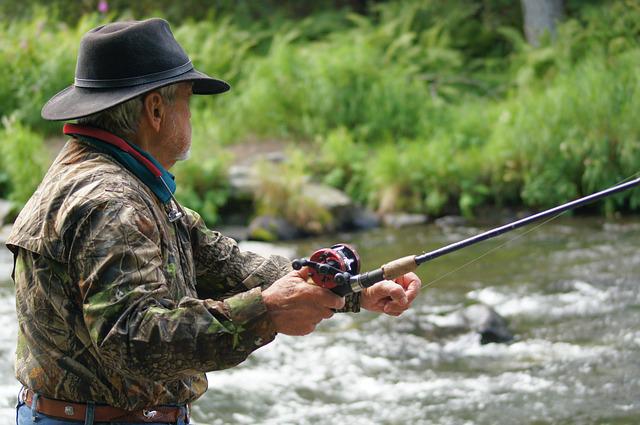Learning to fly fish is simpler than you might think. It’s typically thought of as a difficult technique reserved for seasoned anglers. What is fly fishing? Fly fishing is unlike anything you’ll encounter when using other angling techniques in that it can result in thrilling up-close encounters with fish, which is a highly rewarding and exciting experience. We’ll go over everything you need to know about fly fishing in this guide, including how to start doing it as a sport or hobby.
Table of Contents
What Is Fly Fishing?
Let’s look more closely at the actual mechanics of fly fishing now that we have a general understanding of what it is.
One of the reasons fly fishing is so much fun is because it truly is an art. You have to concentrate on your technique and modify it based on the kind of fish you are trying to catch and the particular location you are in, in addition to being outside in some of the most beautiful places on earth. Occasionally, additional equipment must be used.
First, let’s examine the fly fishing set-up. With traditional fishing, a very fine and light fishing line is used, and the end of the line has a hook, some weights, and a float. You can cast a good distance because of the attached weights and the bait on the hook. The bait is then kept in place by the float at a specific depth in the water. If everything goes according to plan, the fish detects the bait through smell or sight, bites, grapples, and you have dinner.
Fly fishing operates very differently. Fly fishing involves casting a very light “fly” (also known as a line) out over the water’s surface or just below it. Even though the fly itself is extremely light, it must be delicately presented onto the water to prevent scaring off any nearby fish. A combination of casting technique and fly line setup is used to make up for the fly’s lack of weight.
Casting
Another significant distinction between conventional fishing and fly fishing is casting technique. The rod is essentially thrown back and out when fishing the old-fashioned way, which involves pushing a button. More intricate and demanding in terms of art and skill is fly fishing.
There are numerous casting techniques, but they all involve letting out roughly a rod to a rod and a half’s worth of fly line, whipping it back behind you, and then letting it out again. The method you use to do this determines the type of cast, and there are numerous variations and techniques. This video does a great job of demonstrating how different fly fishing casts appear:
The main goal of casting, which is at the heart of fly fishing, is to position the fly so that it appears to the fish to be a real bug actually landing on the water. Only the fly itself will be visible to the fish if everything is done correctly—not the fly line, leader, or tippet.
Species To Target On A Fly Rod
Freshwater Species
Most fly anglers practice their sport in freshwater. The most well-known and traditional type of fishing is trout fishing. In the past, rivers and streams were the primary locations for cold-water fly fishing. But in recent years, fly fishing for predatory fish like pike or bass has grown in popularity, and as a result, still bodies of water like ponds or lakes have become popular fly fishing spots.
Fly fishing for salmon with large two-handed rods is extremely popular on both sides of the Atlantic, in addition to trout fishing. Eastern Canada and Scandinavian fly fishermen use their fly rods to catch Atlantic salmon. It is undoubtedly one of the most sought-after species to catch with a fly rod.
Some of the species that fly fishermen target on the West Coasts of the US and Canada include Pacific salmon and Steelhead (migratory Rainbow trout).
Saltwater Species
Fly fishermen all over the world enjoy saltwater fly fishing very much as well. The species that are often targeted there are very powerful and are therefore a lot of fun to catch on a fly rod. Bonefish, permit, and giant trevally (GT) are some of the most sought-after species to catch on a fly in saltwater. In addition to the Caribbean, a few locations in the Indian Ocean have emerged as hotspots for saltwater fly fishing.
Along with warmer climates where saltwater fly fishing is popular, ocean trout fishing is also popular in Scandinavia, Great Britain, Ireland, and Germany. Fly fishermen prize the seatrout, a migratory variety of brown trout, which inhabits the coasts of these nations.
Fly Fishing Tackle
Rods, reels, lines, leader material (tippet), and flies make up the different types of fly fishing equipment. We’ll look at various fly species a little later.
Fly Rods
We can generally distinguish between single-handed and double-handed rods. So-called switch rods have also become more common over the past few years. They attempt to combine the advantages of single-handed and double-handed rods.
Single Handed Rods
Fly fishermen can tackle a wide range of situations because single-handed rods are available in such a wide range of lengths and weights. As a general rule, they are divided into so-called line classes that range from #1 to #12. The larger and more powerful the fish you target with them is, the higher the number, the heavier the rod.

When you first start fly fishing, a trout rod will probably be what you purchase. Typically, this rod is a #5 (5 weight), and it is about 9 feet (9′) long. With this rod, you can fish for trout and other (smaller) freshwater species like char or grayling in the majority of conditions.
Flies Vs. Lures Vs. Live Bait
Fly fishermen prefer using flies because of their variety of colors, sizes, and patterns. Flies can be made to sit in the water or on top of it, and they are designed to resemble semi-aquatic insects at different stages of their life cycles. Flies can be bought pre-tied or hand-tied, and both options are small, lightweight creations made from thread, natural and synthetic fibers, feathers, fur, beads, and more.
Lures are a type of artificial bait that are sometimes created to resemble small fish and other times are just created to catch the light and move visually appealingly. Jigs, spinners, spoons, crankbaits, and soft plastic worms are some common varieties of lures. Spin fishing and other types of fishing typically involve the use of lures. Fly fishing does not use lures.
When fishing for larger species and game fish, live bait is frequently used (e.g., large nightcrawlers, small fish). Live bait is generally successful but can be difficult to prepare. It is attractive to more active and predatory fish species. For fly fishing, live bait is not used.
Fly Fishing Line
A fly fishing line is the weighted part of a fly fishing rig, despite being lighter in weight than the majority of common types of fishing line. A fly line, in conjunction with a leader and a tippet, is used to subtly cast flies to the surface of the water and guide them to their intended targets. The Fly line has a tapered design and gets thinner near the fly’s end. It is made of lightweight but strong nylon.
How To Fly Fish
In fly fishing, rhythm is everything. To successfully cast a fly rod, you need to find the right rhythm and movement. Casting mechanics can be divided into several steps. Keep in mind that practicing is the best way to learn.
Imagine your arm movements as the hands of a clock to quickly learn how to cast a fly rod. Your arm is at 12 o’clock when it is in its neutral position, which is when it is up and parallel to your body. It should be at 10 o’clock when your arm is extended forward during your cast. Your arm should be at two o’clock while you are performing a back cast. You can maintain control and power in your casts by keeping your arm within this limited range of motion.
Release a little more than a rod length of the colored fly line to begin your cast. One hand should be used to hold the rod; the other hand can be used to manage your line. Swing the rod slowly in the direction of the two o’clock position to begin your cast. Keep the rod tip up, and once the rod tip gets just past your shoulder, at 10 o’clock, make your forward cast in one smooth, continuous motion letting the line rest on top of the water
It’s important to avoid whipping the rod; doing so could cause the fly to break free from the leader or scare off any potential catches.
You can extend more line when casting. As a result, the fish will be closer to your fly and it will be further out on the water. Pull a bit of line from the reel in between casts to extend your line during the throw.
Don’t let the fly touch the water when you make your cast; instead, move the rod several times forward and backward as you normally would. False casting is what is happening here. To find the right rhythm, you should repeatedly practice your false cast. Prepare to release more line once you’ve found your rhythm. Hold the extra line in your other hand while applying some tension to it to let more line out. Release a bit of extra line as you make your forward cast. The cast’s momentum will extend the line and cause it to extend further. Continue doing this until your desired length for your line has been reached.
Be prepared to set the hook if a fish bites your fly. When a fish bites, you can help it stay on your line by setting the hook. Convex (rod) and strip sets are the two methods used to set the hook when fly fishing. When the fish takes your fly, you pull back on the rod abruptly and forcefully, which is known as a convex set. When a fish bites your fly, you pull on the line with your free hand, which is known as a strip set. The strip set is accomplished by giving the line a single, forceful tug while keeping the rod still.
Conclusion
“Whoosh!” cries the thick, yellow fishing line.” as it zips past you before gently landing on the lake in front of you. A tiny lure that floats across the water’s surface and resembles an insect is referred to as a “fly.” A fish tail flashes above the water as a ripple then appears in the same location as your lure. The battle has begun after you set the hook!
Fly fishing is a distinctive and thrilling way to explore our national parks, whether you’re going after 15-pound striped bass, picture-perfect cutthroat, or 6-inch brook trout. Almost no other form of recreation can compare to the tranquility and views it offers.


